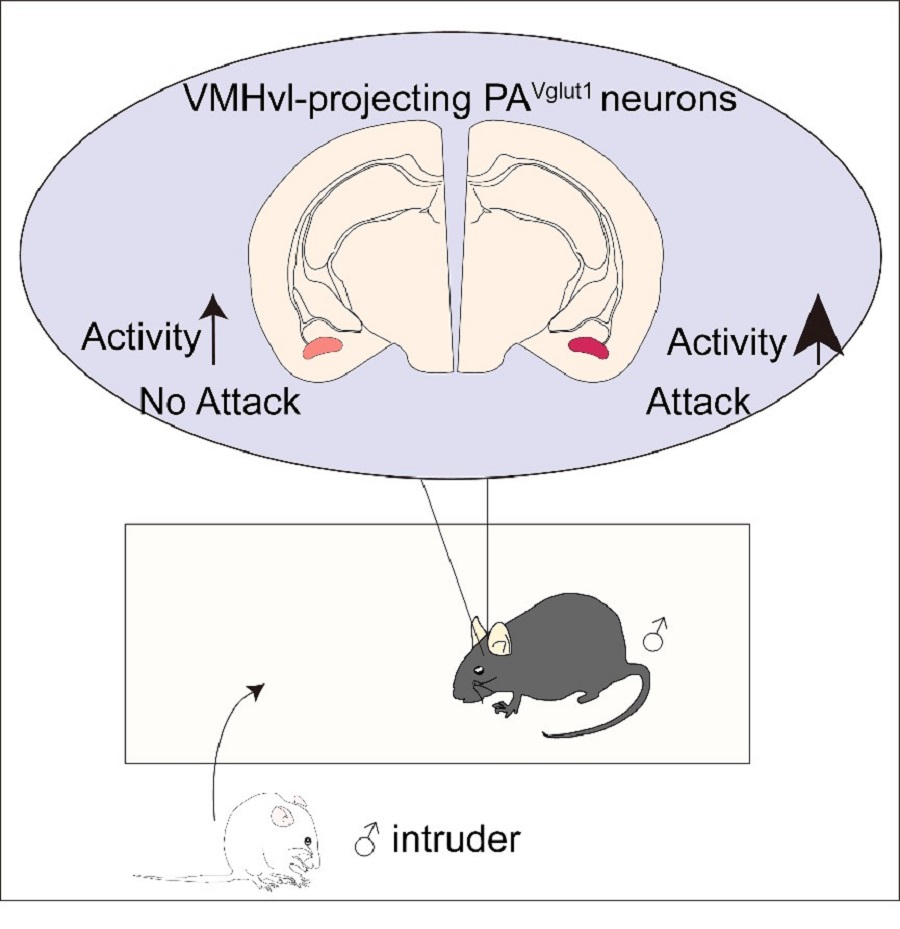Time:2020-04-21
A recent study published in Cell reports demonstrates that cortical inputs from posterior amygdala (PA) onto the ventrolateral part of ventromedial hypothalamus (VMHvl) bidirectionally modulate male aggression behavior in mice. This work was performed by researchers in Dr. XU Xiao-Hong’s Lab at the Institute of Neuroscience, Center for Excellence in Brain Science and Intelligence Technology of the Chinese Academy of Sciences, State Key Laboratory of Neuroscience. The researchers used viral dependent patch clamp assistant circuit mapping, c-Fos staining and fiberphotometry recording, chemogenetic manipulation, to explore how Vglut1+ neurons in PA that send excitatory projections onto VMHvl, bidirectionally modulate male aggression in mice.
Aggression is an evolutionarily conserved innate behavior observed in many species including humans. It is thought to be adaptive by dispersing members of the same species thereby reducing pressure on natural resources required for survival. In humans, pathological aggressive behavior, and of associated affective states, such as anger and rage, are often parts of the behavioral manifestation of mental diseases, especially in mania and bipolar affective disorders. Therefore, understanding the neural substrates and the genetic and environmental factors that influence aggressive behavior, may provide a rational route to new therapies.
Considerable progress has been made recently to elucidate the neural mechanisms that govern territorial aggression in mice. In particular, the VMHvl emerges as an essential node for controlling the initiation and expression of attacks, and other brain regions are thought to act via projections to the VMHvl, either directly or indirectly, to modulate aggression. While Vglut2+ and Vgat+ subcortical inputs to the VMHvl have been previously identified and have been shown to regulate aggression, whether cortical structures also send projections onto the VMHvl and modulate aggression remains unknown.
To this end, using Vglut1+ as a marker for cortical structures they identified a population of neurons in the PA that sent Vglut1+ projections onto VMHvl neurons. In the resident-intruder paradigm, c-Fos expression analysis revealed that activities of PA Vglut1+ neurons clearly differentiated trials whether attacks occurred or not. Furthermore, chemogenetic activation of VMHvl-projecting PA Vglut1+ neurons robustly promoted aggression while inhibition of these neurons reduced attacks. Connectivity mapping showed that VMHvl-projecting PA Vglut1+ neurons received broad inputs from emotion-regulation structures and collaterally projected to the VMHvl and other targets.
In summary, in this project the XU’s Lab successfully identified a population of Vglut1+ neurons in the posterior amygdala that project to the ventrolateral division of ventromedial nucleus of the hypothalamus and bi-directionally modulate territorial attacks.
This work entitled “VMHvl-projecting Vglut1+ neurons in the posterior amygdala gate territorial aggression” was published online in Cell Reports on April 21, 2020. The work was completed by graduate student ZHA Xi supervised by Dr. XU Xiaohong, the head of the laboratory of Innate Behavior. This work was supported by Chinese Academy of Sciences, Shanghai Municipal Government and National Natural Science Foundation of China.

Figure legend: Model for a population of Vglut1+ neurons in the posterior amygdala (PA) that project to the ventrolateral division of ventromedial nucleus of the hypothalamus (VMHvl) and bi-directionally modulate territorial attacks. (Image by CEBSIT)
Keywords: Aggression, Vglut1, posterior amygdala, VMHvl, emotion regulation, neural circuit, cortical gating, innate behaviors
AUTHOR CONTACT:
XU Xiaohong
Center for Excellence in Brain Science and Intelligence Technology of the Chinese Academy of Sciences
E-mail: xiaohong.xu@ion.ac.cn
 附件下载:
附件下载: